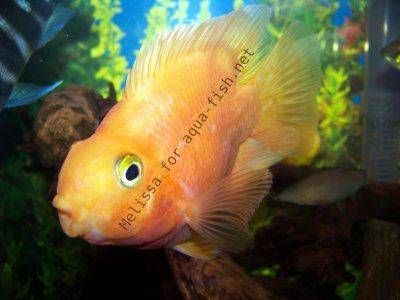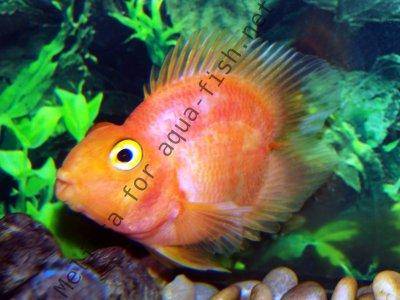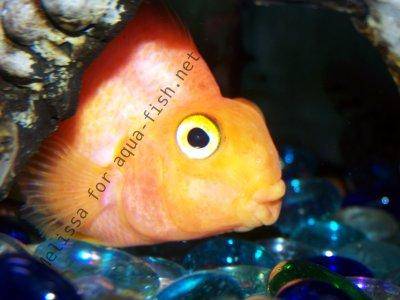Parrot Cichlid Care Guide: Water Conditions, Breeding, Varieties, and FAQs
Quick Links - Answers
Brief Description
This comprehensive guide covers all aspects of raising Parrot Cichlids, from ideal water conditions and dietary needs to breeding tips and detailed FAQs. Feel free to ask questions or share your experiences at the bottom of this page!
Introduction
Parrot Cichlids have become a popular choice in the aquarium hobby due to their unique appearance and vibrant colors. As man-made hybrids, they do not have a scientific name or natural habitat. Most aquarists believe they are a cross between the Red Devil Cichlid and the Severum, though other species like the Midas Cichlid and Red Head Cichlid may also be involved. These hybrids are known for their rounded bodies and beak-like faces, reminiscent of a parrot, hence their name.
The "Blood Parrot Cichlid" is the most commonly seen variety, exhibiting a deep orange coloration. With the right care, these fish can grow up to 8 inches (20.32 cm) in length and live for several decades, with some reports indicating a lifespan of up to 50 years. Their unique characteristics and relatively hardy nature make them a fascinating addition to freshwater tanks.
Water Conditions and Diet
Parrot Cichlids thrive in freshwater aquariums with conditions similar to those of their cichlid ancestors. For optimal health, maintain water temperatures between 72-82°F (22-28°C) and a pH level of 6.0 to 8.0, with a neutral pH around 7.0 being ideal. Use a reliable test kit to regularly monitor these parameters and ensure water stability.
Water Hardness: Moderate water hardness between 4-18 dGH is suitable for Parrot Cichlids. Weekly water changes of 20-30% are essential to maintain water quality. As high waste producers, they require a strong filtration system to keep the tank environment clean. A quality canister filter is recommended to handle their waste and maintain crystal-clear water.
Diet: Parrot Cichlids are omnivores and enjoy a varied diet. Offer high-quality flake or pellet food designed for cichlids, along with frozen or live foods like bloodworms, brine shrimp, and small feeder fish. Feeder fish must be healthy and disease-free to avoid introducing parasites. Quarantine feeder fish before adding them to the tank to ensure their safety. Parrot Cichlids also benefit from the occasional addition of vegetables, such as blanched zucchini and peas. Feed them twice daily, offering only what they can consume within 3-5 minutes to prevent overfeeding and water quality issues.
Sexing
Sexing Parrot Cichlids is notoriously difficult. While some believe females may appear slightly plumper, there are no definitive markers to differentiate males from females. This ambiguity is a direct result of their hybrid nature, making breeding attempts challenging.
Breeding Parrot Cichlids
Parrot Cichlids are egg layers that exhibit typical cichlid breeding behaviors, such as cleaning a flat surface for egg-laying. However, many male Parrot Cichlids are sterile, resulting in unsuccessful spawning attempts. Some breeders attempt hormone injections to boost fertility, but this method is unreliable and ethically questionable.
Despite the breeding challenges, some success has been achieved when female Parrot Cichlids are crossed with males from other cichlid species. This crossbreeding results in various unique hybrid offspring, contributing to the diverse range of Parrot Cichlids available today.
Tank Setup and Maintenance
Parrot Cichlids require a spacious tank of at least 55 gallons (approximately 208 liters). A larger tank is always preferable to provide ample swimming space and reduce territorial disputes. Decorate the tank with caves, driftwood, and dense plants like Anubias or Java Fern. These plants can withstand the cichlid's behavior and provide hiding spots, reducing stress.
Substrate: Use soft substrates like sand or fine gravel to protect their delicate fins and mouths. Incorporate rocks and plants to create visual barriers, establishing distinct territories within the tank. Maintain dim lighting or provide shaded areas to reduce stress and mimic their natural habitat.
Deformities and Disabilities
Parrot Cichlids, being hybrids, often exhibit various deformities, such as malformed spines, swim bladders, and mouths. These deformities can impact their mobility, swimming ability, and feeding behavior. However, they are remarkably adaptable, learning to navigate the tank and crush food in their throats when they cannot use their mouths effectively.
Caring for Deformed Fish: Offer soft food that they can easily crush and avoid large, hard items that could cause choking. Maintaining a clean and stable tank environment is essential, as stressed or weakened fish are more prone to disease. Regular health checks and consistent water quality maintenance will promote their well-being.
Controversy
The breeding of Parrot Cichlids has sparked debate within the aquarium community. Many aquarists argue that intentionally breeding fish with deformities is unethical, as it often results in physical handicaps and health challenges. Others claim that hybrids like the Parrot Cichlid add diversity to the hobby, much like mules serve a purpose in agriculture.
Dyeing Practices: Some Parrot Cichlids, particularly the "Bubblegum Parrots," are dyed for aesthetic purposes. This practice is widely condemned, as dyeing stresses the fish and can shorten their lifespan. Aquarists should avoid purchasing dyed fish to discourage this inhumane practice.
Varieties of Parrot Cichlids
-
Blood Parrot: Characterized by deep orange or reddish coloration, with some specimens exhibiting patches of white or black. Blood Parrots are the most common variety, valued for their vivid hues.
-
Purple Heart Parrot: Lacks a caudal (tail) fin, resulting in a distinctive heart-like shape. Despite this deformity, Purple Heart Parrots can swim as efficiently as other varieties.
-
Bubblegum or Jellybean Parrots: Offspring of a Blood Parrot and Pink Convict Cichlid, often dyed in bright colors. This practice is harmful to the fish and should be avoided to support ethical fishkeeping.
-
Crossbreeds: Produced by crossing Parrot Cichlids with other cichlids to create unique patterns. Examples include parrot-convicts and parrot-flowerhorns, each with distinct characteristics.
Baby Bubble Gum Parrot Cichlid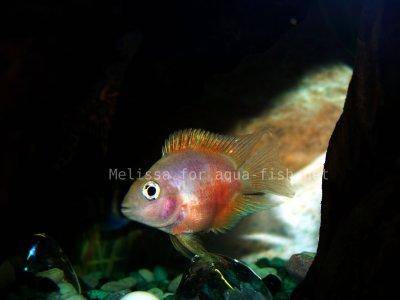
Pink convicts are used to produce bubble gum parrot cichlids for dying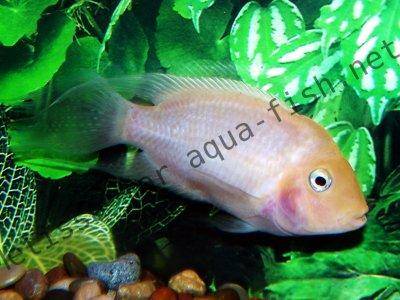
Tank Mates and Behavior
Parrot Cichlids are semi-aggressive, often establishing territories within the tank. Suitable tank mates include other robust cichlids like Severums, Firemouths, and Convict Cichlids. Avoid housing them with small, timid fish, as Parrot Cichlids may outcompete or harass them.
Tip: Introduce tank mates gradually and provide plenty of hiding spots to diffuse aggression. Monitor their behavior closely, especially during the initial weeks, to ensure a peaceful community tank.
FAQs
-
Why did my pink Parrot Cichlid turn orange?
Many Parrot Cichlids, especially those sold as "Bubblegum" or "Jellybean" varieties, are artificially dyed. These dyes fade over time, revealing the fish's natural orange color. Dyeing is considered unethical by many aquarists and can negatively affect the fish's health. Supporting non-dyed fish helps promote responsible fishkeeping.
-
Are Parrot Cichlids genetically deformed on purpose?
Parrot Cichlids are hybrids, and their unique appearance results from selective crossbreeding. Unfortunately, this often leads to physical deformities, such as misshapen mouths or swim bladder issues. While some see them as charming and unique, others criticize the practice for prioritizing appearance over animal welfare. It's a controversial topic within the hobby.
-
Why are these fish even bred if they suffer from deformities?
Parrot Cichlids are bred primarily for their appearance and popularity in the pet trade. Some breeders argue that they are hardy and can live long lives with proper care, while critics argue that breeding fish with known health issues is unethical. As a fishkeeper, it’s up to you to decide where you stand on this issue—and to support breeders who prioritize fish health and welfare.
-
How are artificially colored fish dyed?
Some dyed fish undergo a process where chemicals are used to "open" the skin's protective layer before pigments are added and then sealed. This method is stressful and potentially harmful to the fish. Fortunately, awareness around this issue is increasing, and more aquarists are choosing naturally colored fish.
-
Why are my Parrot Cichlids so nervous?
Stress in Parrot Cichlids can be caused by poor tank conditions, aggressive tank mates, or a lack of hiding spaces. These fish appreciate stable environments and benefit from decorations like caves, driftwood, or dense plants to help them feel secure.
-
How can I reduce aggression in my Parrot Cichlid tank?
Provide a spacious tank with plenty of hiding spots and visual barriers to minimize stress and territorial disputes. Avoid overcrowding and choose compatible tank mates that match in size and temperament.
Rescue Story by Melissa
I once rescued a Parrot Cichlid that was on the brink of death. I found him in a pet shop among other Parrot Cichlids, but he was the weakest in the tank, being constantly picked on by the others. His mouth was deformed, his tail was severely shredded, and a fungal infection had taken hold where pieces of his tail were missing. I took him home and nursed him back to health in my quarantine tank.
After the fungus cleared up and his tail healed, I moved him into the main aquarium with the other cichlids. At that time, he was one of the larger fish in the tank, which housed a Convict, Flowerhorn, Peacock, and Red Jewel Cichlid. It was a fairly new setup, with only a few bottom feeders initially. The Parrot Cichlid gradually got used to his new surroundings and other tank mates, coming out of hiding more frequently as time passed.
Eventually, he teamed up with the Flowerhorn, and together they ruled the entire aquarium. Now, the Parrot Cichlid and the Flowerhorn are the two largest fish in the tank. The Parrot Cichlid has truly become the "king of the tank" and is living his life as happily as can be.
Conclusion
Parrot Cichlids are unique and vibrant fish that make a striking addition to freshwater aquariums. Despite the challenges in caring for them and the ethical debates surrounding their breeding, they can thrive in a well-maintained tank. By understanding their needs, behavior, and the controversies involved, aquarists can ensure these fascinating fish lead healthy and fulfilling lives.
Have questions or wish to share your Parrot Cichlid experiences? Use the form at the bottom of this page to connect with other aquarists!






